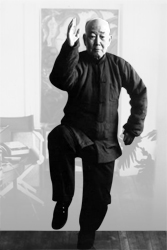
Tai Chi masters are known for maintaining vitality, balance and mobility well into old age. Don's first Tai Chi teacher, T.T. Liang, lived to be 102, and in his mid-eighties was still throwing young, large guys around in the Tai Chi game--somewhat akin to upright grappling or sumo--called "push hands" (tuishou).
His consummate skill with Chinese weapons—sword, cutlass, staff, spear—was still evident well into his 90's.
Don says:
In the ten years I studied with him, I cannot say I ever saw Master Liang lose his balance. What is more, I learned much later that he was practicing Tai Chi on severely compromised feet, permanently damaged by the horrendous torture he endured at the hands of the Japanese during WWII.
Many other Tai Chi masters are notable for their sustained "youthfulness" of the legs and hips, supple and strong in the decades when many are becoming stiff and weak.
Some of these effects are probably the result of simply continuing to exercise and move around, in fairly complex ways, and never "retiring" from movement. But they are also, I believe, in large part the embodiment of 3 major Tai Chi Principles, that are central to the art and developed fully over many decades of practice.
One of these 3 major principles is Central Equilibrium.
Listen as Don explains the key Tai Chi concept of Central Equilibrium.
[powerpress]
In tomorrow's lesson, you will learn a simple exercise to feel your Central Equilibrium.

Click here to share this course with your Friends on Facebook and help us spread the word about the potent benefits of Tai Chi Balance Training.
Did you stumble on to this page while browsing DanKleiman.com? It's part of a free, week-long Tai Chi Balance course. Learn all about it here.

Share this post
Twitter
Google+
Facebook
Reddit
LinkedIn
StumbleUpon
Pinterest
Email